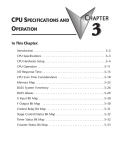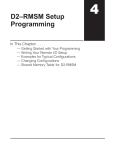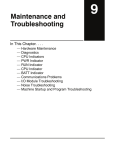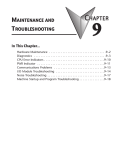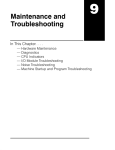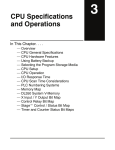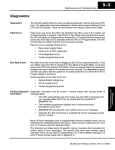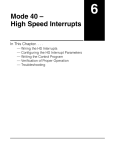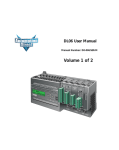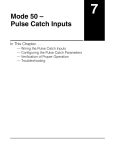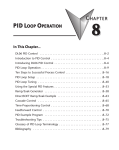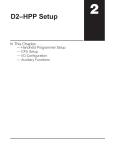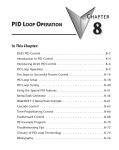Download Chapter 4 - AutomationDirect
Transcript
CPU Specifications and Operation In This Chapter. . . . — Introduction — CPU Specifications — CPU Hardware Setup — CPU Operation — Program Mode Operation — Run Mode Operation — I/O Response Time — CPU Scan Time Considerations — PLC Numbering Systems — Memory Map — DL105 System V-Memory — X Input Bit Map — Y Output Bit Map — Control Relay Bit Map — Stage Control / Status Bit Map — Timer Status Bit Map — Counter Status Bit Map 14 4--2 CPU Specifications and Operation Introduction The Central Processing Unit (CPU) is the heart of the Micro PLC. Almost all PLC operations are controlled by the CPU, so it is important that it is set up correctly. This chapter provides the information needed to understand: S Steps required to set up the CPU S Operation of ladder program, organization of Variable Memory Power Input DL105 PLC Main Power Supply 8 Discrete Outputs Commons Output Circuit Comm. Port CPU Auxiliary +24VDC Supply To Programming Device, or Operator Interface Input Circuit +24VDC Out 10 Discrete Inputs (AC--powered versions only) Commons CPU Specifications and Operation NOTE: The High-Speed I/O function (HSIO) consists of dedicated but configurable hardware in the DL105. It is not considered part of the CPU, because it does not execute the ladder program. For more on HSIO operation, see Chapter 3. DL105 CPU Features The DL105 Micro PLC which has 2.4K words of memory comprised of 2.0K of ladder memory and 384 words of V-memory (data registers). Program storage is in the FLASH memory which is a part of the CPU board in the PLC. In addition, there is RAM with the CPU which will store system parameters, V-memory, and other data which is not in the application program. The RAM is backed up by a “super-capacitor”, storing the data for several days in the event of a power outage. The capacitor automatically charges during powered operation of the PLC. The DL105 supports fixed I/O which includes ten discrete input points and eight output points. No provision for expansion beyond these eighteen I/O points are available in the F1--130 model PLCs. Over 90 different instructions are available for program development as well as extensive internal diagnostics that can be monitored from the application program or from an operator interface. Chapter 5 provides a detailed description of the instructions. The DL105 provides one built-in RS232C communication port, so you can easily connect a handheld programmer or a personal computer without needing any additional hardware. DL105 PLC User Manual, 3rd Edition CPU Specifications and Operation 4--3 CPU Specifications Feature DL105 Total Program memory (words) 2.4K Ladder memory (words) 2048 Total V--memory (words) (See Appendix E) 384 User V--memory (words) 256 Non-volatile V--Memory (words) 128 3.3 μS Typical scan (boolean) 4 -- 6 mS RLL Ladder style Programming Yes RLL and RLL PLUS Programming Yes Run Time Edits Yes Variable / fixed scan Variable Supports Override No Handheld programmer Yes DirectSOFT programming for Windows™ Yes Built-in communication ports (RS232C) Yes EEPROM or FLASH Standard on CPU Local Discrete I/O points available 18 Local Analog input / output channels maximum None High-Speed I/O (quad., pulse out, interrupt, pulse catch, etc.) Yes I/O Point Density 10 inputs, 8 outputs Number of instructions available (see Chapter 5 for details) 91 Control relays 256 Special relays (system defined) 112 Stages in RLL PLUS 256 Timers 64 Counters 64 Immediate I/O Yes Interrupt input (external / timed) Yes Subroutines No For/Next Loops No Math Integer Drum Sequencer Instruction Yes Time of Day Clock/Calendar No Internal diagnostics Yes Password security Yes System error log No User error log No Battery backup No (uses super-cap.) DL105 PLC User Manual, 3rd Edition CPU Specifications and Operation Contact execution (boolean) 4--4 CPU Specifications and Operation CPU Hardware Setup CPU Status Indicators RUN ON OFF FLASHING CPU is in RUN mode CPU is in Program mode CPU is in Upgrade mode CPU ON OFF CPU internal diagnostics has detected an error. CPU is OK. ON OFF CPU power good CPU power failure PWR Communications Port Communication Port Com 1 Connects to HPP, DirectSOFT, operator interfaces, etc. 6-pin, RS232C 9600 Baud Odd parity Station address fixed (1) 8 data bits 1 start, 1 stop bit Asynchronous, Half-duplex, DTE K sequence protocol 6 5 4 3 2 1 CPU Specifications and Operation CPU Status Indicators Communication Port Pinout Diagrams Cables are available that allow you to quickly and easily connect a Handheld Programmer or a personal computer to the DL105 PLCs. However, if you need to build your own cables, use the pinout diagrams shown. The DL105 PLCs require an RJ-12 phone plug to fit the built-in jacks. The Micro PLC has one built-in RS232C communication port. The port is generally used for programming either with the Handheld Programmer or DirectSOFT, and has a fixed station address of 1. The baud rate is fixed at 9600 baud. This port supports the K--sequence protocol, which is a proprietary protocol. 6 5 4321 Phone Jack Connector Port Pinouts Pin Signal Definition 1 2 3 4 5 0V 5V RS232C Data in RS232C Data out 5V NOTE: The 5V pins are rated at 200mA maximum, primarilly for use with some operator interface units. DL105 PLC User Manual, 3rd Edition CPU Specifications and Operation Connecting the Programming Devices 4--5 If you’re using a Personal Computer with the DirectSOFT programming package, you can connect the computer to the DL105’s programming port. For an engineering office environment (typical during program development), this is the preferred method of programming. Use cable part no. D2--DSCBL The Handheld programmer is connected to the CPU with a handheld programmer cable. This device is ideal for maintaining existing installations or making small program changes. The handheld programmer is shipped with a cable, which is approximately 6.5 feet (200 cm) long. For replacement cable, use part no. DV--1000CBL Even if you have years of experience using PLCs, there are a few things you need to do before you can start entering programs. This section includes some basic things, such as changing the CPU mode, but it also includes some things that you may never have to use. Here’s a brief list of the items that are discussed. S Using Auxiliary Functions S Selecting and Changing the CPU Modes S Clearing the program (and other memory areas) S How to initialize system memory S Setting retentive memory ranges The following paragraphs provide the setup information necessary to get the CPU ready for programming. They include setup instructions for either type of programming device you are using. The D2--HPP Handheld Programmer Manual provides the Handheld keystrokes required to perform all of these operations. The DirectSOFT Manual provides a description of the menus and keystrokes required to perform the setup procedures via DirectSOFT. DL105 PLC User Manual, 3rd Edition CPU Specifications and Operation CPU Setup Information 4--6 CPU Specifications and Operation There are two possible operating modes available with DL105 Micro PLCs. S RUN — executes program and updates I/O points. S PROGRAM — allows program changes. The CPU halts execution of the ladder program and all output points are turned off. Mode of Operation The DL105 operates as follows when the power is connected. at Power-up 1. The DL105 CPU will normally power-up in the mode that it was in just prior to the power interruption. For example, if the CPU was in Program Mode when the power was disconnected, the CPU will power-up in Program Mode (see warning note below). 2. You can configure the DL105 to always power-up in the Run Mode. You can set bit 13 in V7633 (nonvolatile memory) to enable this feature; we’ll show you how to set the bit later in this chapter. CPU Modes WARNING: If bit 13 in memory location V7633 is not set, once the super capacitor has discharged the system memory may not retain the previous mode of operation. When this occurs, the PLC can power-up in either Run or Program Mode. There is no way to determine which mode will be entered. Failure to adhere to this warning greatly increases the risk of unexpected equipment startup. CPU Specifications and Operation Changing Modes in The DL105 Micro PLC does not have an external switch to switch CPU operating the DL105 PLC modes. You have to use a programming device, such as the handheld programmer or DirectSOFT, to change the operating mode. You can use either DirectSOFT or the Handheld Programmer to change the CPU mode of operation. With DirectSOFT you use a menu option in the PLC menu. With the Handheld Programmer, you use the MODE key. Menu Options DL105 PLC User Manual, 3rd Edition MODE Key 4--7 CPU Specifications and Operation Setting Bits in V7633 You can use the Handheld Programmer or DirectSOFT to set the proper bits in V7633. Since you cannot access the bits individually, you have to enter a constant that will result in the appropriate bit being set. The first two digits of the constant are used to select the CPU options. The second two digits are used with the High-Speed I/O function to select various options. If you’re using High Speed I/O functions, make sure you also enter the appropriate code for the feature selected If you want the HSIO inputs and outputs to default to regular I/O point operation, just enter 60 as the last two digits of the code. This configures all I/O points to operate only as standard discrete I/O. The diagram shows how the upper and lower bytes of V7633 are used. For example, if you entered 2060 into V7633, the powerup-in-run option is selected, and the discrete filtered inputs are selected. V7633 -- 16 bits CPU Setup Bit 15 14 13 12 11 10 HSIO Mode Select 9 8 0 0 1 0 00 0 0 2 7 6 5 4 3 2 1 0 0 1 1 0 0 0 0 0 0 6 Codes: Codes: 00: Default 10: Up Counter 0 20: Power-up in Run 20: Quadrature 30: Pulse output (High Speed) 40: Interrupt (High Speed) 50: Pulse catch (High Speed) 60: Discrete Filtered Input (default) The following keystrokes show how you can enter the codes into V7633 with the D2--HPP Handheld Programmer. Select V7633 for Monitoring CLR V AND CLR H 7 V 7634 V7633 0001 0000 SHFT G 6 D 3 D 3 STAT SHFT K JMP C 2 A 0 G 6 A 0 ENT V 7634 V7633 K2060 Since the changes take affect immediately, you may receive an error message. For example, if you select Power-up in Run Mode and the CPU does not yet contain a program, an error will occur. DL105 PLC User Manual, 3rd Edition CPU Specifications and Operation Enter the Code 4--8 CPU Specifications and Operation Auxiliary Functions Many CPU setup tasks involve the use of Auxiliary (AUX) Functions. The AUX Functions perform many different operations, ranging from clearing ladder memory, displaying the scan time, copying programs to EEPROM in the handheld programmer, etc. They are divided into categories that affect different system parameters. Appendix A provides a description of the AUX functions. You can access the AUX Functions from DirectSOFT or from the D2--HPP Handheld Programmer. The manuals for those products provide step-by-step procedures for accessing the AUX Functions. Some of these AUX Functions are designed specifically for the Handheld Programmer setup, so they will not be needed (or available) with the DirectSOFT package. The following table shows a list of the Auxiliary functions for the Handheld Programmer. AUX 2* — RLL Operations 21 Check Program 61 Show Revision Numbers 22 Change Reference 62 Beeper On / Off 23 Clear Ladder Range 65 Run Self Diagnostics 24 Clear All Ladders AUX 7* — EEPROM Operations 71 Copy CPU memory to HPP EEPROM 72 Write HPP EEPROM to CPU 73 Compare CPU to HPP EEPROM Show I/O Configuration 74 Blank Check (HPP EEPROM) AUX 5* — CPU Configuration 75 Erase HPP EEPROM 76 Show EEPROM Type (CPU and HPP) AUX 3* — V--Memory Operations 31 Clear V--Memory AUX 4* — I/O Configuration 41 CPU Specifications and Operation AUX 6* — Handheld Programmer Configuration 51 Modify Program Name 53 Display Scan Time 54 Initialize Scratchpad 81 Modify Password 55 Set Watchdog Timer 82 Unlock CPU 57 Set Retentive Ranges 83 Lock CPU 58 Test Operations 5B HSIO Configuration DL105 PLC User Manual, 3rd Edition AUX 8* — Password Operations CPU Specifications and Operation Clearing an Existing Program Before you enter a new program, be sure to always clear ladder memory. You can use AUX Function 24 to clear the complete program. You can also use other AUX functions to clear other memory areas. AUX 23 — Clear Ladder Range AUX 24 — Clear all Ladders AUX 31 — Clear V--Memory S S S Initializing System Memory 4--9 The DL105 Micro PLC maintain system parameters in a memory area often referred to as the “scratchpad”. In some cases, you may make changes to the system setup that will be stored in system memory. For example, if you specify a range of Control Relays (CRs) as retentive, these changes are stored in system memory. AUX 54 resets the system memory to the default values. WARNING: You may never have to use this feature unless you want to clear any setup information that is stored in system memory. Usually, you’ll only need to initialize the system memory if you are changing programs and the old program required a special system setup. You can usually load in new programs without ever initializing system memory. Remember, this AUX function will reset all system memory. If you have set special parameters such as retentive ranges, etc. they will be erased when AUX 54 is used. Make sure you that you have considered all ramifications of this operation before you select it. Setting Retentive Memory Ranges The DL105 PLCs provide certain ranges of retentive memory by default. The default ranges are suitable for many applications, but you can change them if your application requires additional retentive ranges or no retentive ranges at all. (see Appendix E) The default settings are: Memory Area DL105 Default Range Available Range C300 -- C377 C0 -- C377 V--Memory V2000 -- V2377 V0 -- V2377 Timers None by default T0 -- T77 Counters CT0 -- CT77 CT0 -- CT77 Stages None by default S0 -- S377 You can use AUX 57 (see Appendix A) to set the retentive ranges. You can also use DirectSOFT menus to select the retentive ranges. WARNING: The DL105 PLCs do not have battery back-up. The super capacitor will retain the values in the event of a power loss, but only for a short period of time, depending on conditions. If the retentive ranges are important for your application, make sure you program critical parameters into EEPROM locations. DL105 PLC User Manual, 3rd Edition CPU Specifications and Operation Control Relays 4--10 CPU Specifications and Operation Using a Password The DL105 PLCs allow you to use a password to help minimize the risk of unauthorized program and/or data changes. Once you enter a password you can “lock” the PLC against access. Once the CPU is locked you must enter the password before you can use a programming device to change any system parameters. You can select an 8-digit numeric password. The Micro PLCs are shipped from the factory with a password of 00000000. All zeros removes the password protection. If a password has been entered into the CPU you cannot just enter all zeros to remove it. Once you enter the correct password, you can change the password to all zeros to remove the password protection. WARNING: Make sure you remember your password. If you forget your password you will not be able to access the CPU. The Micro PLC must be returned to the factory to have the password removed. You can use the D2--HPP Handheld Programmer or DirectSOFT to enter a password. The following diagram shows how you can enter a password with the Handheld Programmer. DirectSOFT D2--HPP Select AUX 81 CLR CLR I 8 B 1 AUX ENT PASSWORD 00000000 Enter the new 8-digit password CPU Specifications and Operation X X X ENT PASSWORD XXXXXXXX Press CLR to clear the display There are three ways to lock the CPU once the password has been entered. 1. If the CPU power is disconnected, the CPU will be automatically locked against access. 2. If you enter the password with DirectSOFT, the CPU will be automatically locked against access when you exit DirectSOFT. 3. Use AUX 83 to lock the CPU. When you use DirectSOFT, you will be prompted for a password if the CPU has been locked. If you use the Handheld Programmer, you have to use AUX 82 to unlock the CPU. Once you enter AUX 82, you will be prompted to enter the password. DL105 PLC User Manual, 3rd Edition CPU Specifications and Operation 4--11 CPU Operation Achieving the proper control for your equipment or process requires a good understanding of how DL105 CPUs control all aspects of system operation. There are four main areas to understand before you create your application program: S CPU Operating System — the CPU manages all aspects of system control. A quick overview of all the steps is provided in the next section. S CPU Operating Modes — The two primary modes of operation are Program Mode and Run Mode. S CPU Timing — The two important areas we discuss are the I/O response time and the CPU scan time. S CPU Memory Map — DL105 CPUs offer a wide variety of resources, such as timers, counters, inputs, etc. The memory map section shows the organization and availability of these data types. CPU Operating System Power up Initialize hardware Initialize various memory based on retentive configuration Update input Service peripheral Update Special Relays PGM Mode? CPU Specifications and Operation At powerup, the CPU initializes the internal electronic hardware. Memory initialization starts with examining the retentive memory settings. In general, the contents of retentive memory is preserved, and non-retentive memory is initialized to zero (unless otherwise specified). After the one-time powerup tasks, the CPU begins the cyclical scan activity. The flowchart to the right shows how the tasks differ, based on the CPU mode and the existence of any errors. The “scan time” is defined as the average time around the task loop. Note that the CPU is always reading the inputs, even during program mode. This allows programming tools to monitor input status at any time. The outputs are only updated in Run mode. In program mode, they are in the off state. Error detection has two levels. Non-fatal errors are reported, but the CPU remains in its current mode. If a fatal error occurs, the CPU is forced into program mode and the outputs go off. RUN Execute program Update output Do diagnostics OK OK? YES NO Report error, set flag register, turn on LED Fatal error NO YES Force CPU into PGM mode DL105 PLC User Manual, 3rd Edition 4--12 CPU Specifications and Operation Program Mode CPU Specifications and Operation Run Mode In Program Mode, the CPU does not execute the application program or update the output points. The primary use for Program Mode is to enter or change an application program. You also use program mode to set up the CPU parameters, such as HSIO features, retentive memory areas, etc. You can use a programming device, such as DirectSOFT or the D2--HPP Handheld Programmer to place the CPU in Program Mode. In Run Mode, the CPU executes the application program and updates the I/O system. You can perform many operations during Run Mode. Some of these include: S Monitor and change I/O point status S Update timer/counter preset values S Update Variable memory locations Run Mode operation can be divided into several key areas. For the vast majority of applications, some of these execution segments are more important than others. For example, you need to understand how the CPU updates the I/O points, handles forcing operations, and solves the application program. The remaining segments are not that important for most applications. You can use DirectSOFT or the D2--HPP Handheld Programmer to place the CPU in Run Mode. Download Program Normal Run mode scan Read Inputs Service Peripherals Update Special Relays Solve the Application Program Write Outputs Diagnostics You can also edit the program during Run Mode. The Run Mode Edits are not “bumpless” to the outputs. Instead, the CPU maintains the outputs in their last state while it accepts the new program information. If an error is found in the new program, then the CPU will turn all the outputs off and enter the Program Mode. This feature is discussed in more detail in Chapter 8. WARNING: Only authorized personnel fully familiar with all aspects of the application should make changes to the program. Changes during Run Mode become effective immediately. Make sure you thoroughly consider the impact of any changes to minimize the risk of personal injury or damage to equipment. DL105 PLC User Manual, 3rd Edition CPU Specifications and Operation Read Inputs 4--13 The CPU reads the status of all inputs, then stores it in the image register. Input image register locations are designated with an X followed by a memory location. Image register data is used by the CPU when it solves the application program. Of course, an input may change after the CPU has just read the inputs. Generally, the CPU scan time is measured in milliseconds. If you have an application that cannot wait until the next I/O update, you can use Immediate Instructions. These do not use the status of the input image register to solve the application program. The Immediate instructions immediately read the input status directly from the I/O modules. However, this lengthens the program scan since the CPU has to read the I/O point status again. A complete list of the Immediate instructions is included in Chapter 5. WARNING: Only authorized personnel fully familiar with all aspects of the application should make changes to the program. Make sure you thoroughly consider the impact of any changes to minimize the risk of personal injury or damage to equipment. Update Special There are certain V-memory locations that contain Special Relays and other Relays and Special dedicated register information. This portion of the execution cycle makes sure these locations get updated on every scan. Also, there are several different Special Registers Relays, such as diagnostic relays, etc., that are also updated during this segment. DL105 PLC User Manual, 3rd Edition CPU Specifications and Operation Service Peripherals After the CPU reads the inputs from the input modules, it reads any attached peripheral devices. This is primarily a communications service for any attached and Force I/O devices. For example, it would read a programming device to see if any input, output, or other memory type status needs to be modified. Forced I/O— temporarily changes the status of a discrete bit. For example, you may want to force an input on, even though it is really off. This allows you to change the point status that was stored in the image register. This value will be valid until the image register location is written to during the next scan. This is primarily useful during testing situations when you just need to force a bit on to trigger another event. Forced Inputs — The CPU reads the status of X inputs during the Read Inputs portion of the scan. When the CPU services the programming device, it logs any request to force an X input on. If the input is used in the application program, the ladder X contact is considered closed (on). Since an X input is a real-world input point, the CPU will change the status when it reads the inputs on the next scan. Forced Outputs— Outputs which are not used in the program can be forced on and off for troubleshooting and maintenance purposes. You can temporarily allow the forcing of any output by inserting an END coil instruction at the beginning of the ladder program. Then you can use DirectSOFT or a HPP to force outputs on and off. The DL105 PLCs only retain the forced value for one scan. There is an exception to this rule. For example, if the point address is greater than X11 or Y7 or it is not used in the ladder program, then the point will maintain the forced status. 4--14 CPU Specifications and Operation Solve Application Program The CPU evaluates each instruction in the application program during this segment of the scan cycle. The instructions define the relationship between the input conditions and the desired output response. The CPU uses the output image register area to store the status of the desired action for the outputs. Output image register locations are designated with a Y followed by a memory location. The actual outputs are updated during the write outputs segment of the scan cycle. There are immediate output instructions available that will update the output points immediately instead of waiting until the write output segment. A complete list of the Immediate instructions is provided in Chapter 5. The internal control relays (C), the stages (S), and the variable memory (V) are also updated in this segment. Normal Run mode scan Read Inputs Service Peripherals Update Special Relays Solve the Application Program Write Outputs Diagnostics CPU Specifications and Operation You may recall that you can force various types of points in the system. (This was discussed earlier in this chapter.) If any I/O points or memory data have been forced, the output image register also contains this information. Write Outputs Once the application program has solved the instruction logic and constructed the output image register, the CPU writes the contents of the output image register to the corresponding output points. Remember, the CPU also made sure that any forcing operation changes were stored in the output image register, so the forced points get updated with the status specified earlier. Diagnostics During this part of the scan, the CPU performs all system diagnostics and other tasks such as calculating the scan time and resetting the watchdog timer. There are many different error conditions that are automatically detected and reported by the DL105 PLCs. Appendix B contains a listing of the various error codes. Probably one of the more important things that occurs during this segment is the scan time calculation and watchdog timer control. The DL105 CPU has a “watchdog” timer that stores the maximum time allowed for the CPU to complete the solve application segment of the scan cycle. If this time is exceeded the CPU will enter the Program Mode and turn off all outputs. The default value set from the factory is 200 ms. An error is automatically reported. For example, the Handheld Programmer would display the following message “E003 S/W TIMEOUT” when the scan overrun occurs. You can use AUX 53 to view the minimum, maximum, and current scan time. Use AUX 55 to increase or decrease the watchdog timer value. DL105 PLC User Manual, 3rd Edition CPU Specifications and Operation 4--15 I/O Response Time Is Timing Important I/O response time is the amount of time required for the control system to sense a change in an input point and update a corresponding output point. In the majority of for Your applications, the CPU performs this task in such a short period of time that you may Application? never have to concern yourself with the aspects of system timing. However, some applications do require extremely fast update times. In these cases, you may need to know how to to determine the amount of time spent during the various segments of operation. There are four things that can affect the I/O response time. S The point in the scan cycle when the field input changes states S Input Off to On delay time S CPU scan time S Output Off to On delay time The next paragraphs show how these items interact to affect the response time. Normal Minimum I/O Response The I/O response time is shortest when the input changes just before the Read Inputs portion of the execution cycle. In this case the input status is read, the application program is solved, and the output point gets updated. The following diagram shows an example of the timing for this situation. Scan Scan Solve Program Solve Program Read Inputs Solve Program Solve Program Write Outputs Field Input CPU Writes Outputs CPU Specifications and Operation CPU Reads Inputs Input Off/On Delay Output Off/On Delay I/O Response Time In this case, you can calculate the response time by simply adding the following items: Input Delay + Scan Time + Output Delay = Response Time DL105 PLC User Manual, 3rd Edition 4--16 CPU Specifications and Operation Normal Maximum I/O Response The I/O response time is longest when the input changes just after the Read Inputs portion of the execution cycle. In this case the new input status does not get read until the following scan. The following diagram shows an example of the timing for this situation. Scan Scan Solve Program Solve Program Read Inputs Solve Program Solve Program Write Outputs Field Input CPU Reads Inputs CPU Writes Outputs Input Off/On Delay Output Off/On Delay I/O Response Time In this case, you can calculate the response time by simply adding the following items: CPU Specifications and Operation Input Delay +(2 x Scan Time) + Output Delay = Response Time DL105 PLC User Manual, 3rd Edition CPU Specifications and Operation 4--17 There are a few things you can do the help improve throughput. S You can choose instructions with faster execution times S You can use immediate I/O instructions (which update the I/O points during the program execution) S You can use the HSIO Mode 50 Pulse Catch features designed to operate in high-speed environments. See the Chapter 3 for details on using this feature. Of these three things the Immediate I/O instructions are probably the most important and most useful. The following example shows how an immediate input instruction and immediate output instruction would affect the response time. Improving Response Time Scan Scan Solve Program Solve Program Normal Read Input Read Input Immediate Solve Program Write Output Immediate Solve Program Normal Write Outputs Field Input Input Off/On Delay Output Off/On Delay I/O Response Time In this case, you can calculate the response time by simply adding the following items. The instruction execution time would be calculated by adding the time for the immediate input instruction, the immediate output instruction, and any other instructions in between the two. NOTE: Even though the immediate instruction reads the most current status from I/O, it only uses the results to solve that one instruction. It does not use the new status to update the image register. Therefore, any regular instructions that follow will still use the image register values. Any immediate instructions that follow will access the I/O again to update the status. DL105 PLC User Manual, 3rd Edition CPU Specifications and Operation Input Delay + Instruction Execution Time + Output Delay = Response Time 4--18 CPU Specifications and Operation CPU Scan Time Considerations CPU Specifications and Operation The scan time covers all the cyclical tasks that are performed by the operating system. You can use DirectSOFT or the Handheld Programmer to display the minimum, maximum, and current scan times that have occurred since the previous Program Mode to Run Mode transition. This information can be very important when evaluating the performance of a system. As we’ve shown previously there are several segments that make up the scan cycle. Each of these segments requires a certain amount of time to complete. Of all the segments, the following are the most important. S Input Update S Peripheral Service S Program Execution S Output Update S Timed Interrupt Execution The only one you really have the most control over is the amount of time it takes to execute the application program. This is because different instructions take different amounts of time to execute. So, if you think you need a faster scan, then you can try to choose faster instructions. Your choice of I/O type and peripheral devices can also affect the scan time. However, these things are usually dictated by the application. The following paragraphs provide some general information on how much time some of the segments can require. Power up Initialize hardware Initialize various memory based on retentive configuration Update input Service peripheral Update Special Relays PGM Mode? RUN Execute program Update output Do diagnostics OK OK? YES NO Report error, set flag register, turn on LED Fatal error NO YES Force CPU into PGM mode Reading Inputs The time required during each scan to read the input status is 40 μS. Don’t confuse this with the I/O response time that was discussed earlier. Writing Outputs The time required to write the output status is 629 μS. Don’t confuse this with the I/O response time that was discussed earlier. DL105 PLC User Manual, 3rd Edition CPU Specifications and Operation 4--19 The CPU processes the program from address 0 to the END instruction. The CPU Application Program Execution executes the program left to right and top to bottom. As each rung is evaluated the appropriate image register or memory location is updated. The time required to solve the application program depends on the type and number of instructions used, and the amount of execution overhead. Just add the execution times for all the instructions in your program to determine to total execution time. Appendix C provides a complete list of the instruction execution times for the DL105 Micro PLC. For example, the execution time for running the program shown below is calculated as follows: Instruction Time STR X0 OR C0 ANDN X1 OUT Y0 STRN C100 LD K10 STRN C101 OUT V2002 STRN C102 LD K50 STRN C103 OUT V2006 STR X5 ANDN X10 OUT Y3 END 3.3 μs 2.7 μs 2.7 μs 3.4 μs 3.9 μs 62 μs 3.9 μs 60 μs 3.9 μs 62 μs 3.9 μs 60 μs 3.3 μs 2.7 μs 3.4 μs 27 μs TOTAL DL105 0.86 mS 3.85 ms X1 Y0 OUT C0 C100 LD C101 OUT C102 LD C103 X5 OUT X10 K10 V2002 K50 V2006 Y3 OUT END The program above takes only 308.1 μs to execute during each scan. The total scan time is the sum of the program execution plus the overhead as shown above. “Overhead” includes all other housekeeping and diagnostic tasks. The scan time will vary slightly from one scan to the next, because of fluctuation in overhead tasks. NOTE: You can move words to EEPROM from within the application program. This can add up to 10ms per 32 word boundary. Program Control Instructions — the DL105 PLCs have an interrupt routine feature that changes the way a program executes. Since this instruction interrupts normal program flow, it will have an effect on the program execution time. For example, a timed interrupt routine with a 10 mS period interrupts the main program execution (before the END statement) every 10 mS, so the CPU can execute the interrupt routine. Chapter 5 provides detailed information on interrupts. DL105 PLC User Manual, 3rd Edition CPU Specifications and Operation Overhead Minimum Maximum 308.1 μs X0 4--20 CPU Specifications and Operation PLC Numbering Systems If you are a new PLC user or are using DirectLOGIC PLCs for the first time, please take a moment to study how our PLCs use numbers. You’ll find that each PLC manufacturer has their own conventions on the use of numbers in their PLCs. We want to take just a moment to familiarize you with how numbers are used in DirectLOGIC PLCs. The information you learn here applies to all our PLCs! CPU Specifications and Operation PLC Resources octal 1482 ? BCD ? binary 0402 ? 7 --961428 ASCII hexadecimal 1001011011 177 1011 ? decimal A 72B ? --300124 3A9 ? 3 As any good computer does, PLCs store and manipulate numbers in binary form: just ones and zeros. So why do we have to deal with numbers in so many different forms? Numbers have meaning, and some representations are more convenient than others for particular purposes. Sometimes we use numbers to represent a size or amount of something. Other numbers refer to locations or addresses, or to time. In science we attach engineering units to numbers to give a particular meaning (see Appendix G for numbering system details). PLCs offer a fixed amount of resources, depending on the model and configuration. We use the word “resources” to include variable memory (V-memory), I/O points, timers, counters, etc. Most modular PLCs allow you to add I/O points in groups of eight. In fact, all the resources of our PLCs are counted in octal. It’s easier for computers to count in groups of eight than ten, because eight is an even power of 2. Octal means simply counting in groups of eight things at a time. In the figure to the right, there are eight circles. The quantity in decimal is “8”, but in octal it is “10” (8 and 9 are not valid in octal). In octal, “10” means 1 group of 8 plus 0 (no individuals). Decimal 1 2 3 4 5 6 7 8 Octal 1 2 3 4 5 6 7 10 In the figure below, we have two groups of eight circles. Counting in octal we have “20” items, meaning 2 groups of eight, plus 0 individuals Don’t say “twenty”, say “two--zero octal”. This makes a clear distinction between number systems. Decimal 1 2 3 4 5 6 7 8 9 10 11 12 13 14 15 16 11 12 13 14 15 16 17 20 1 2 3 4 5 6 7 10 Octal After counting PLC resources, it’s time to access PLC resources (there’s a difference). The CPU instruction set accesses resources of the PLC using octal addresses. Octal addresses are the same as octal quantities, except they start counting at zero. The number zero is significant to a computer, so we don’t skip it. Our circles are in an array of square X= 0 1 2 3 4 5 6 7 containers to the right. To access a X resource, our PLC instruction will address its location using the octal references 1X shown. If these were counters, “CT14” 2X would access the black circle location. DL105 PLC User Manual, 3rd Edition 4--21 CPU Specifications and Operation V--Memory Variable memory (called “V-memory”) stores data for the ladder program and for configuration settings (see Appendix E). V-memory locations and V-memory addresses are the same thing, and are numbered in octal. For example, V2073 is a valid location, while V1983 is not valid (“9” and “8” are not valid octal digits). Each V-memory location is one data word wide, meaning 16 bits. For configuration registers, our manuals will show each bit of a V-memory word. The least significant bit (LSB) will be on the right, and the most significant bit (MSB) on the left. We use the word “significant”, referring to the relative binary weighting of the bits. V-memory address (octal) V2017 Binary-Coded Decimal Numbers V-memory data (binary) MSB LSB 0 1 0 0 1 1 1 0 0 0 1 0 1 0 0 1 V-memory data is 16-bit binary, but we rarely program the data registers one bit at a time. We use instructions or viewing tools that let us work with decimal, octal, and hexadecimal numbers. All these are converted and stored as binary for us. A frequently-asked question is “How do I tell if a number is octal, BCD, or hex”? The answer is that we usually cannot tell just by looking at the data... but it does not really matter. What matters is: the source or mechanism which writes data into a V-memory location and the thing which later reads it must both use the same data type (i.e., octal, hex, binary, or whatever). The V-memory location is just a storage box... that’s all. It does not convert or move the data on its own. Since humans naturally count in decimal (10 fingers, 10 toes), we prefer to enter and view PLC data in decimal as well. However, computers are more efficient in using pure binary numbers. A compromise solution between the two is Binary-Coded Decimal (BCD) representation. A BCD digit ranges from 0 to 9, and is stored as four binary bits (a nibble). This permits each V-memory location to store four BCD digits, with a range of decimal numbers from 0000 to 9999. BCD number 9 3 6 0 1 0 0 1 0 0 1 0 0 1 1 0 1 1 0 In a pure binary sense, a 16-bit word can represent numbers from 0 to 65535. In storing BCD numbers, the range is reduced to only 0 to 9999. Many math instructions use Binary-Coded Decimal (BCD) data, and DirectSOFT and the handheld programmer allow us to enter and view data in BCD. Hexadecimal Numbers Hexadecimal numbers are similar to BCD numbers, except they utilize all possible binary values in each 4-bit digit. They are base-16 numbers so we need 16 different digits. To extend our decimal digits 0 through 9, we use A through F as shown. Decimal Hexadecimal 0 1 2 3 0 1 2 3 4 5 4 5 6 6 7 7 8 9 10 11 12 13 14 15 8 9 A B C D E F A 4-digit hexadecimal number can represent all 65536 values in a V-memory word. The range is from 0000 to FFFF (hex). PLCs often need this full range for sensor data, etc. Hexadecimal is just a convenient way for humans to view full binary data. Hexadecimal number V-memory storage A 7 F 4 1 0 1 0 0 1 1 1 1 1 1 1 0 1 0 0 DL105 PLC User Manual, 3rd Edition CPU Specifications and Operation V-memory storage 4 4--22 CPU Specifications and Operation Memory Map With any PLC system, you generally have many different types of information to process. This includes input device status, output device status, various timing elements, parts counts, etc. It is important to understand how the system represents and stores the various types of data. For example, you need to know how the system identifies input points, output points, data words, etc. The following paragraphs discuss the various memory types used in DL105 Micro PLCs. A memory map overview for the CPU follows the memory descriptions. Octal Numbering System All memory locations and resources are numbered in Octal (base 8). For example, the diagram shows how the octal numbering system works for the discrete input points. Notice the octal system does not contain any numbers with the digits 8 or 9. X0 X1 X2 X3 X4 X5 X6 X7 X10 X11 CPU Specifications and Operation Discrete and Word Locations V--Memory Locations for Discrete Memory Areas As you examine the different memory types, you’ll notice two types of memory in the DL105, discrete and word memory. Discrete memory is one bit that can be either a 1 or a 0. Word memory is referred to as V--memory (variable) and is a 16-bit location normally used to manipulate data/numbers, store data/numbers, etc. Some information is automatically stored in V--memory. For example, the timer current values are stored in V--memory. Discrete -- On or Off, 1 bit X0 Word Locations -- 16 bits 0 1 0 1 00 0 0 0 0 1 0 0 1 0 1 The discrete memory area is for inputs, outputs, control relays, special relays, stages, timer status bits and counter status bits. However, you can also access the bit data types as a V-memory word. Each V-memory location contains 16 consecutive discrete locations. For example, the following diagram shows how the X input points are mapped into V-memory locations. 10 Discrete (X) Input Points X11 X10 Bit # 15 14 13 12 11 10 9 8 X7 X6 X5 X4 X3 X2 X1 X0 7 6 5 4 3 2 1 0 V40400 These discrete memory areas and their corresponding V--memory ranges are listed in the memory area table for DL105 Micro PLCs on the following pages. DL105 PLC User Manual, 3rd Edition 4--23 CPU Specifications and Operation Input Points (X Data Type) The discrete input points are noted by an X data type. There are 10 discrete input points available with DL105 CPUs. In this example, the output point Y0 will be turned on when input X0 energizes. Output Points (Y Data Type) The discrete output points are noted by a Y data type. There are 128 discrete output points available with DL105 CPUs. In this example, output point Y1 will be turned on when input X1 energizes. Control Relays (C Data Type) Control relays are discrete bits normally used to control the user program. The control relays do not represent a real world device, that is, they cannot be physically tied to switches, output coils, etc. They are internal to the CPU. Because of this, control relays can be programmed as discrete inputs or discrete outputs. These locations are used in programming the discrete memory locations (C) or the corresponding word location which contains 16 consecutive discrete locations. In this example, memory location C5 will energize when input X10 turns on. The second rung shows a simple example of how to use a control relay as an input. Timer status bits reflect the relationship between the current value and the preset value of a specified timer. The timer status bit will be on when the current value is equal or greater than the preset value of a corresponding timer. When input X0 turns on, timer T1 will start. When the timer reaches the preset of 3 seconds (K of 30) timer status contact T1 turns on. When T1 turns on, output Y12 turns on. Turning off X0 resets the timer. Y0 OUT X1 Y1 OUT X10 C5 OUT C5 Y10 OUT Y20 OUT X0 T1 TMR K30 T1 Y12 OUT DL105 PLC User Manual, 3rd Edition CPU Specifications and Operation Timers and Timer Status Bits (T Data type) X0 4--24 CPU Specifications and Operation Timer Current Values (V Data Type) Counters and Counter Status Bits (CT Data type) As mentioned earlier, some information is automatically stored in V--memory. This is true for the current values associated with timers. For example, V0 holds the current value for Timer 0, V1 holds the current value for Timer 1, etc. The primary reason for this is programming flexibility. The example shows how you can use relational contacts to monitor several time intervals from a single timer. Counter status bits that reflect the relationship between the current value and the preset value of a specified counter. The counter status bit will be on when the current value is equal to or greater than the preset value of a corresponding counter. X0 TMR T1 K1000 V1 K30 Y2 OUT V1 K50 Y3 OUT V1 K75 V1 X0 K100 CNT K10 Y4 OUT CT3 X1 CT3 Y2 OUT Each time contact X0 transitions from off to on, the counter increments by one. (If X1 comes on, the counter is reset to zero.) When the counter reaches the preset of 10 counts (K of 10) counter status contact CT3 turns on. When CT3 turns on, output Y12 turns on. CPU Specifications and Operation Counter Current Values (V Data Type) Just like the timers, the counter current values are also automatically stored in V--memory. For example, V1000 holds the current value for Counter CT0, V1001 holds the current value for Counter CT1, etc. The primary reason for this is programming flexibility. The example shows how you can use relational contacts to monitor the counter values. DL105 PLC User Manual, 3rd Edition X0 CNT K10 CT3 X1 V1003 K1 Y2 OUT V1003 K3 Y3 OUT V1003 K5 V1003 K8 Y4 OUT 4--25 CPU Specifications and Operation Word Memory (V Data Type) Word memory is referred to as V--memory (variable) and is a 16-bit location normally used to manipulate data/numbers, store data/numbers, etc. (see Appendix E). Some information is automatically stored in V--memory. For example, the timer current values are stored in V--memory. The example shows how a four-digit BCD constant is loaded into the accumulator and then stored in a V-memory location. X0 LD OUT 0 0 0 1 00 1 1 0 1 0 0 0 1 0 1 Special relays are discrete memory locations with pre-defined functionality. There are many different types of special relays. For example, some aid in program development, others provide system operating status information, etc. Appendix D provides a complete listing of the special relays. In this example, control relay C10 will energize for 50 ms and de-energize for 50 ms because SP5 is a pre--defined relay that will be on for 50 ms and off for 50 ms. 3 4 5 Ladder Representation ISG S0000 Wait forStart Start S1 JMP X0 SG S500 JMP Check for a Part S0001 Part Present S2 JMP X1 Part Present S6 JMP X1 SG Clamp the part S0002 Clamp SET S400 S3 JMP Part Locked X2 SP5 C10 OUT SP4: 1 second clock SP5: 100 ms clock SP6: 50 ms clock DL105 PLC User Manual, 3rd Edition CPU Specifications and Operation Special Relays (SP Data Type) Stages are used in RLL PLUS Stage programs to create a structured program, similar to a flowchart. Each program stage denotes a program segment. When the program segment, or stage, is active, the logic within that segment is executed. If the stage is off, or inactive, the logic is not executed and the CPU skips to the next active stage. (See Chapter 7 for a more detailed description of RLL PLUS Stage programming.) Each stage also has a discrete status bit that can be used as an input to indicate whether the stage is active or inactive. If the stage is active, then the status bit is on. If the stage is inactive, then the status bit is off. This status bit can also be turned on or off by other instructions, such as the SET or RESET instructions. This allows you to easily control stages throughout the program. V2000 Word Locations -- 16 bits 1 Stages (S Data type) K1345 4--26 CPU Specifications and Operation DL105 System V-memory System Parameters and Default Data Locations (V Data Type) The DL105 PLCs reserve several V-memory locations for storing system parameters or certain types of system data. These memory locations store things like the error codes, High-Speed I/O data, and other types of system setup information. CPU Specifications and Operation System V-memory Description of Contents V2320--V2377 The default location for multiple preset values for the High-Speed Counter V7620--V7627 Locations for DV--1000 operator interface parameters Default Values / Ranges N/A V7620 Sets the V-memory location that contains the value. V0 -- V2377 V7621 Sets the V-memory location that contains the message. V0 -- V2377 V7622 Sets the total number (1 -- 16) of V-memory locations to be displayed. 1 -- 16 V7623 Sets the V-memory location that contains the numbers to be displayed. V0 -- V2377 V7624 Sets the V-memory location that contains the character code to be displayed. V0 -- V2377 V7625 Contains the function number that can be assigned to each key. V-memory location for X, Y, or C points used. V7626 Powerup operational mode. 0, 1, 2, 12, 3 V7627 Change preset value. 0000 to 9999 V7630 Starting location for the multi--step presets for channel 1. The default value is 2320, which indicates the first value should be obtained from V2320. Since there are 24 presets available, the default range is V2320 -- V2377. You can change the starting point if necessary. Default: V2320 Range: V0 -- V2320 V7631--V7632 Not used N/A V7633 Sets the desired function code for the high speed counter, interrupt, pulse catch, pulse train, and input filter. Location is also used for setting the power-up in Run Mode option. Default: 0060 Lower Byte Range: Range: 10 -- Counter 20 -- Quadrature 30 -- Pulse Out 40 -- Interrupt 50 -- Pulse Catch 60 -- Filtered discrete In. Upper Byte Range: Bits 8 -- 12, 14,15: Unused Bit 13: Power-up in Run V7634 X0 Setup Register for High-Speed I/O functions Default: 1006 V7635 X1 Setup Register for High-Speed I/O functions Default: 1006 V7636 X2 Setup Register for High-Speed I/O functions Default: 1006 V7637 X3 Setup Register for High-Speed I/O functions Default: 1006 DL105 PLC User Manual, 3rd Edition CPU Specifications and Operation System V-memory Description of Contents V7640--V7642 Locations for DV--1000 operator interface parameters. 4--27 Default Values / Ranges V7640 Title Timer preset value pointer. V2000--V2377 V7641 Titled Counter preset value pointer. V2000--V2377 V7642 HiByte--Titled Timer preset block size, LoByte--Titled counter preset block size. 1--99 V7643--V7647 Not used V7751 Fault Message Error Code — stores the 4-digit code used with the FAULT instruction when the instruction is executed. N/A V7752--V7754 Not used N/A V7755 Error code — stores the fatal error code. V7756 Error code — stores the major error code. V7757 Error code — stores the minor error code. V7760--V7762 Not used V7763 Program address where syntax error exists N/A V7764 Syntax error code N/A V7765 Scan — stores the total number of scan cycles that have occurred since the last Program Mode to Run Mode transition. N/A V7666--V7774 Not used N/A V7775 Scan — stores the current scan time (milliseconds). N/A V7776 Scan — stores the minimum scan time that has occurred since the last Program Mode to Run Mode transition (milliseconds). N/A V7777 Scan — stores the maximum scan time that has occurred since the last Program Mode to Run Mode transition (milliseconds). N/A CPU Specifications and Operation DL105 PLC User Manual, 3rd Edition 4--28 CPU Specifications and Operation DL105 Aliases An alias is an alternate way of referring to certain memory types, such as timer/counter current values, V--memory locations for I/O points, etc., which simplifies understanding the memory address. The use of the alias is optional, but some users may find the alias to be helpful when developing a program. The table below shows how the aliases can be used to reference memory locations. Address Start Alias Start V0 TA0 V1000 CTA0 V1000 is the counter accumulator value for counter 0, therefore, it’s alias is CTA0. CTA1 is the alias for V1001, etc. VGX0 V40000 is the word memory reference for discrete bits GX0 through GX17, therefore, it’s alias is VGX0. V40001 is the word memory reference for discrete bits GX20 through GX 37, therefore, it’s alias is VGX20. VGY0 V40200 is the word memory reference for discrete bits GY0 through GY17, therefore, it’s alias is VGY0. V40201 is the word memory reference for discrete bits GY20 through GY 37, therefore, it’s alias is VGY20. VX0 V40400 is the word memory reference for discrete bits X0 through X17, therefore, it’s alias is VX0. V40401 is the word memory reference for discrete bits X20 through X37, therefore, it’s alias is VX20. VY0 V40500 is the word memory reference for discrete bits Y0 through Y17, therefore, it’s alias is VY0. V40501 is the word memory reference for discrete bits Y20 through Y37, therefore, it’s alias is VY20. VC0 V40600 is the word memory reference for discrete bits C0 through C17, therefore, it’s alias is VC0. V40601 is the word memory reference for discrete bits C20 through C37, therefore, it’s alias is VC20. VS0 V41000 is the word memory reference for discrete bits S0 through S17, therefore, it’s alias is VS0. V41001 is the word memory reference for discrete bits S20 through S37, therefore, it’s alias is VS20. VT0 V41100 is the word memory reference for discrete bits T0 through T17, therefore, it’s alias is VT0. V41101 is the word memory reference for discrete bits T20 through T37, therefore, it’s alias is VT20. VCT0 V41140 is the word memory reference for discrete bits CT0 through CT17, therefore, it’s alias is VCT0. V41141 is the word memory reference for discrete bits CT20 through CT37, therefore, it’s alias is VCT20. VSP0 V41200 is the word memory reference for discrete bits SP0 through SP17, therefore, it’s alias is VSP0. V41201 is the word memory reference for discrete bits SP20 through SP37, therefore, it’s alias is VSP20. V40000 V40200 V40400 V40500 CPU Specifications and Operation V40600 V41000 V41100 V41140 V41200 DL105 PLC User Manual, 3rd Edition Example V0 is the timer accumulator value for timer 0, therefore, it’s alias is TA0. TA1 is the alias for V1, etc.. CPU Specifications and Operation 4--29 DL105 Memory Map Memory Type Discrete Memory Reference (octal) Word Memory Reference (octal) Qty. Decimal Symbol Input Points (See note 1) X0 -- X177 V40400 -- V40407 128 X0 Output Points (See note 1) Y0 -- Y177 V40500 -- V40507 128 Y0 Control Relays C0 -- C377 V40600 -- V40617 256 Special Relays SP0 -- SP117 SP540 -- SP577 V41200 -- V41204 V41226 -- V41227 112 Timers T0 -- T77 Timer Current Values None V0 -- V77 64 Timer Status Bits T0 -- T77 V41100 -- V41103 64 Counters CT0 -- CT77 C0 C0 SP0 64 TMR K100 V0 T0 K100 T0 64 CNT CT0 K10 None V1000 -- V1077 64 Counter Status Bits CT0 -- CT77 V41140 -- V41143 64 Data Words None (See Appendix E) V2000 -- V2377 256 None specific, used with many instructions Data Words None Non--volatile (See Appendix E) V4000 -- V4177 128 None specific, used with many instructions Stages V41000 -- V41017 256 System parameters S0 -- S377 None V7620 -- V7647 V7750--V7777 48 V1000 K100 CT0 SG S0 S 001 None specific, used for various purposes 1 -- The DL105 systems are limited to 10 discrete inputs and 8 discrete outputs with the present available hardware, but 128 point addresses exist. DL105 PLC User Manual, 3rd Edition CPU Specifications and Operation Counter Current Values 4--30 CPU Specifications and Operation X Input Bit Map This table provides a listing of individual Input points associated with each V-memory address bit for the DL105’s ten physical inputs. Actual available references are X0 to X177 (V40400 -- V40407). MSB DL105 Input (X) Points LSB 15 14 13 12 11 10 9 8 7 6 5 4 3 2 1 0 -- -- -- -- -- -- 011 010 007 006 005 004 003 002 001 000 Address V40400 Y Output Bit Map This table provides a listing of individual output points associated with each V-memory address bit for the DL105’s eight physical outputs. Actual available references are Y0 to Y177 (V40500 -- V40507). MSB DL105 Output (Y) Points LSB 15 14 13 12 11 10 9 8 7 6 5 4 3 2 1 0 -- -- -- -- -- -- -- -- 007 006 005 004 003 002 001 000 Address V40500 Control Relay Bit Map This table provides a listing of the individual control relays associated with each V-memory address bit. CPU Specifications and Operation MSB DL105 Control Relays (C) LSB Address 15 14 13 12 11 10 9 8 7 6 5 4 3 2 1 0 017 016 015 014 013 012 011 010 007 006 005 004 003 002 001 000 V40600 037 036 035 034 033 032 031 030 027 026 025 024 023 022 021 020 V40601 057 056 055 054 053 052 051 050 047 046 045 044 043 042 041 040 V40602 077 076 075 074 073 072 071 070 067 066 065 064 063 062 061 060 V40603 117 116 115 114 113 112 111 110 107 106 105 104 103 102 101 100 V40604 137 136 135 134 133 132 131 130 127 126 125 124 123 122 121 120 V40605 157 156 155 154 153 152 151 150 147 146 145 144 143 142 141 140 V40606 177 176 175 174 173 172 171 170 167 166 165 164 163 162 161 160 V40607 217 216 215 214 213 212 211 210 207 206 205 204 203 202 201 200 V40610 237 236 235 234 233 232 231 230 227 226 225 224 223 222 221 220 V40611 257 256 255 254 253 252 251 250 247 246 245 244 243 242 241 240 V40612 277 276 275 274 273 272 271 270 267 266 265 264 263 262 261 260 V40613 317 316 315 314 313 312 311 310 307 306 305 304 303 302 301 300 V40614 337 336 335 334 333 332 331 330 327 326 325 324 323 322 321 320 V40615 357 356 355 354 353 352 351 350 347 346 345 344 343 342 341 340 V40616 377 376 375 374 373 372 371 370 367 366 365 364 363 362 361 360 V40617 DL105 PLC User Manual, 3rd Edition 4--31 CPU Specifications and Operation Stage Control / Status Bit Map This table provides a listing of individual Staget control bits associated with each V-memory address bit. MSB DL105 Stage (S) Control Bits LSB Address 15 14 13 12 11 10 9 8 7 6 5 4 3 2 1 0 017 016 015 014 013 012 011 010 007 006 005 004 003 002 001 000 V41000 037 036 035 034 033 032 031 030 027 026 025 024 023 022 021 020 V41001 057 056 055 054 053 052 051 050 047 046 045 044 043 042 041 040 V41002 077 076 075 074 073 072 071 070 067 066 065 064 063 062 061 060 V41003 117 116 115 114 113 112 111 110 107 106 105 104 103 102 101 100 V41004 137 136 135 134 133 132 131 130 127 126 125 124 123 122 121 120 V41005 157 156 155 154 153 152 151 150 147 146 145 144 143 142 141 140 V41006 177 176 175 174 173 172 171 170 167 166 165 164 163 162 161 160 V41007 217 216 215 214 213 212 211 210 207 206 205 204 203 202 201 200 V41010 237 236 235 234 233 232 231 230 227 226 225 224 223 222 221 220 V41011 257 256 255 254 253 252 251 250 247 246 245 244 243 242 241 240 V41012 277 276 275 274 273 272 271 270 267 266 265 264 263 262 261 260 V41013 317 316 315 314 313 312 311 310 307 306 305 304 303 302 301 300 V41014 337 336 335 334 333 332 331 330 327 326 325 324 323 322 321 320 V41015 357 356 355 354 353 352 351 350 347 346 345 344 343 342 341 340 V41016 377 376 375 374 373 372 371 370 367 366 365 364 363 362 361 360 V41017 Timer Status Bit Map This table provides a listing of individual timer contacts associated with each V-memory address bit. DL105 Timer (T) Contacts LSB Address 15 14 13 12 11 10 9 8 7 6 5 4 3 2 1 0 017 016 015 014 013 012 011 010 007 006 005 004 003 002 001 000 V41100 037 036 035 034 033 032 031 030 027 026 025 024 023 022 021 020 V41101 057 056 055 054 053 052 051 050 047 046 045 044 043 042 041 040 V41102 077 076 075 074 073 072 071 070 067 066 065 064 063 062 061 060 V41103 Counter Status Bit Map This table provides a listing of individual counter contacts associated with each V-memory address bit. MSB DL105 Counter (CT) Contacts LSB Address 15 14 13 12 11 10 9 8 7 6 5 4 3 2 1 0 017 016 015 014 013 012 011 010 007 006 005 004 003 002 001 000 V41140 037 036 035 034 033 032 031 030 027 026 025 024 023 022 021 020 V41141 057 056 055 054 053 052 051 050 047 046 045 044 043 042 041 040 V41142 077 076 075 074 073 072 071 070 067 066 065 064 063 062 061 060 V41143 DL105 PLC User Manual, 3rd Edition CPU Specifications and Operation MSB































